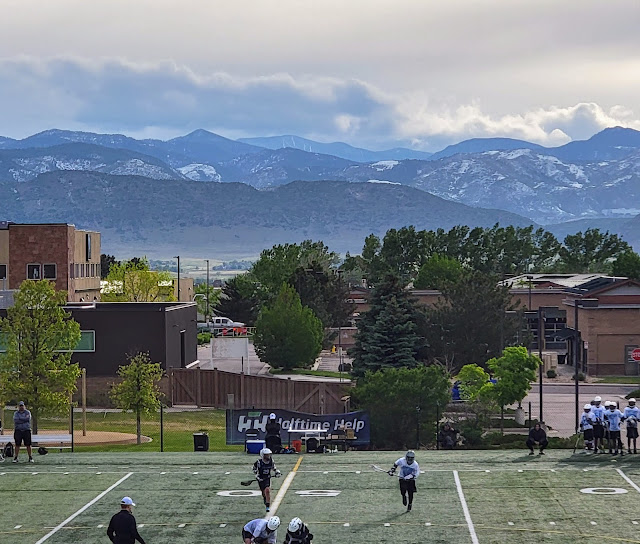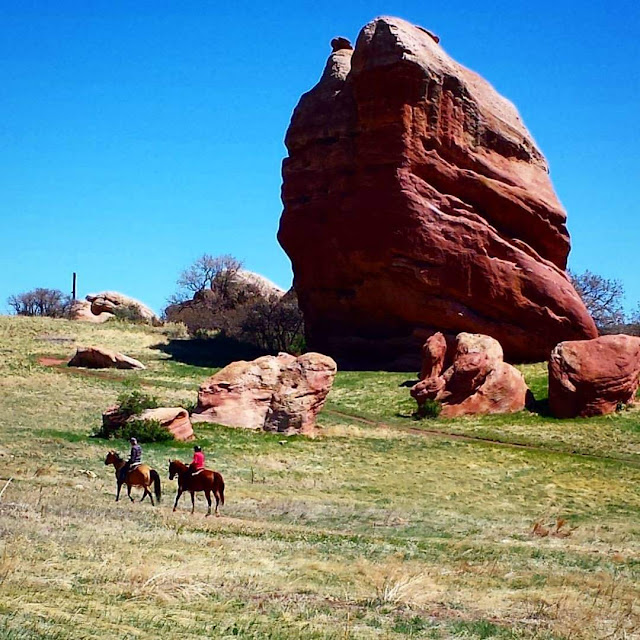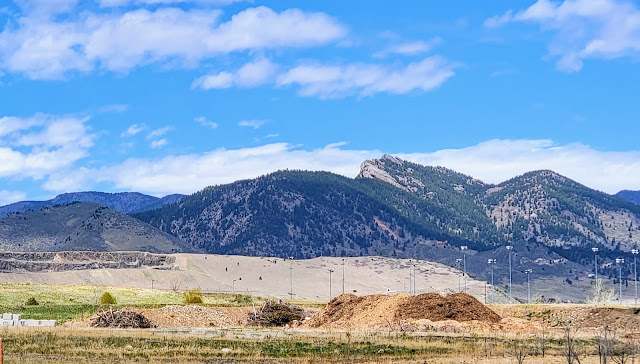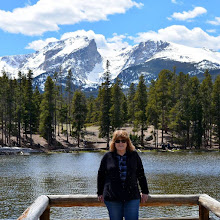An archeologist who is a member of our historical society asked for volunteers among the other members to meet this spring to do an important archaeological survey of an area where there was a wildfire in an open space on the east side of a local hogback last December.
An archaeological survey is collect information about the location, distribution, and organization of past human cultures across a large area. Several published archaeological documents indicate that just after a fire is a more productive time to search for surface artifacts before vegetation begins to regrow. This area in Colorado has shown many past archaeological finds from people. The Ken-Caryl South Valley Archaeological District contains rock shelters that were used by prehistoric peoples from at least the Late Paleo-Indian Period (before 6000 BCE) through the Early Ceramic period (150–1150 CE)
As you can see from this photo, the grass is already growing back...
When this 150-acre wildfire occurred last December our community was very fortunate that the winds became milder as time passed and that a single-engine air tanker from Fort Collins was able to drop water on the fire to help emergency crews battle the spread. We were evacuated from our home for a short time during this fire and I learned a few valuable lessons from that experience, which I blogged about in this post.
Sadly, just a few days later, Colorado experienced the devastating Marshall Fire, in which two lives were lost and over 1,000 homes were burned to the ground. There were "Red Flag" conditions that day with drought conditions and high winds and that wildfire moved very quickly for many miles. It even crossed a six-lane concrete highway! The cause of that fire is still under investigation.
On a chilly windy day in early April our community archaeologist, three colleagues from the Colorado Archaeological Society--CAS, an Open Space ranger, and eleven community volunteers arrived to do the archaeological survey, one of the volunteers was my husband. Each volunteer was given a grid area to cover by foot, a GPS, and pin flags to place into the ground if they saw anything of interest so a trained eye of an archaeologist would be able to do a more thorough examination. They slowly walked an area rectangle about 2 miles long and 300 yards wide, looking down for artifacts for around 2 1/2 hours.
The photo collage above is of some of the interesting items found during this survey. The descriptions are from the report our archaeologist sent to all the participants:
#1 (left photo in the collage) A prehistoric stone tool that appears to be a pointed hammer stone.
#2 (middle photo) A prehistoric grinding stone, often called a "mano" in archaeological circles. Parallel scars on the tool caused by grinding are on several surfaces. These manos were used along with a flat stone surface, often called a "metate" to process food and
sometimes paint.
#3 (right photo) A prehistoric stone tool with signs of human manufacture.
All the GPS locations of these artifacts were also recorded in the official report.
A probable fire ring. These are made by people of all past eras.
Some other interesting geological samples were collected by a resident geologist for further study.
The report concluded that the density of artifacts found in this survey was low. It appeared that the prehistoric and historic people did not use the eastern hogback slope to a high degree as they used the west hogback slope and valley where hundreds of artifacts have been found in past surveys and digs.
A couple of years ago my husband and I assisted in an archeological dig on a foothill in our neighborhood. which you can see in this post. A burn pit and stone tools were found in that dig that was carbon-dated to the Early Ceramic Period 150–1150 CE. It is always so fascinating to think that people lived and thrived in our area so long ago! They may even have had interesting visitors, which you can read about in this post about the possibility of Celtic Ogham writings found nearby.
I wanted to be one of the volunteers on this survey, but I had a scheduling conflict this time. A group of friends I've kept in touch with since high school, who all live in different states, were having a Zoom birthday celebration for a friend in the group, and I did not want to miss that. We lost one of our close high school friends last year in a tragic car accident, and we now find that we treasure our Zoom times together even more than ever.
Meanwhile, "Red Flag Fire Warnings" are becoming a common occurrence here. As much as we enjoy assisting with archaeological surveys, I'm hoping that there won't be the need for another burn scar survey in our area anytime soon! We hope May will bring the rains that April forgot in our area.
I'm linking this post to some of the following blog events:
Mosaic Monday, Blue Monday, Through My Lens Monday, Hearth, and Soul Link Party, You Are the Star Blog Hop, Inspire Me Monday, Home Matters Linky Party, Good Random Fun, Nature Notes, Grand Social, Travel Photos, Travel Tuesday, Happiness Is Homemade, Ruby Tuesday, Tuesday's Treasures, Tuesdays With A Twist, Wordless Wednesday on a Tuesday, Wordless Wednesday, Oh My Heartsie Girl's Wonderful Wednesday, Wednesday My Corner of the World, Wonderful Wednesday, Signs2, Little Things Thursday, Thankful Thursday, Thursday Encouraging Hearts and Home, Thursday Favorite Things, Wandering Camera--last Thursday of the month--Friendship Fridays, Friday Features Linky Party, Skywatch Friday, Pink Saturday, Saturday Sparks, Saturday Critters, Sunday on Silverado



































































